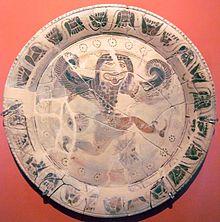Anagyrus or Anagyrous (Ancient Greek: Ἀναγυροῦς), also Anagyruntus or Anagyrountos (Ἀναγυροῦντος), was a deme of ancient Athens, belonging to the phyle Erechtheis, situated in the south of Attica near the promontory Zoster.[1][2] Pausanias mentions at this place a temple of the mother of the gods.[3]
The ruins of Anagyrus have been found near Vari.[4][5]
The ancient name was maintained until 600 AD, as mentioned by geographer and historian Stephanus of Byzantium.
Anagyrous is an important archaeological site that still remains unexplored, with traces of human habitation dating back to 3rd millennium BCE, that include:[6]
- The fortification and acropolis of Lathouriza (7th - 3rd century BC)
- The remains of 25 small houses
- A sacred altar
- Ten funerary precincts
- A major Mycenaean cemetery
- A cemetery and Palestrina of the Classical period
- The Cave of the Nymphs and Pan (converted to a sanctuary by Archedimus with statues of Cybele, Hermes, Pan and others)
Eumenes of Anagyrus and the Anagyrus Painter were from the town.
Etymology
According to one version, the name derives from the mythical Anagyrous, whose temple was located in the region. Anagyrous made the homes near his sacred grove tremble and collapse. He once exterminated an entire family who had cut trees from his sacred grove—hence the ancient proverb, "Anagryasion Daimon". Offerings and sacrifices were brought to Anagryous as attempts to appease his anger.
Another version derives from the plant Anagyris (Anagyris foe dita), referred to as emetic and as a laxative by Dioscorides (9-79 AD), and as an exorcism of ill fate by the Byzantine Suidas dictionary. The plant grows abundantly in the valley, exuding a terrible stench when touched or shaken. Aristophanes (Lysias 68) cites the following humorist dialogue:
«Πόθεν εισίν; Αναγυρουντόθεν. Νη τον Δία, ο γουν Ανάγυρος μη κεκινήσθαι δοκεί.»
(Pothen eisin? Anagyrountothen. Nee ton Dia, o goun Anagyros me kekinisthai dokei)
(Where are you from? From Anagyron, By Zeus, better not shake the Anagyron.)
According to Aelian, the countryside near Anagyrous was where Aristion and Periktyoni (Plato's parents) used to lull baby Plato.
«... εν ταις πλησίον μυρρίναις, δασείες ούσες και πυκνές, καθεύδοντι δε εσμός μελισσών εν τοις χείλεσι αυτού καθίσασαι, υπήδον την του Πλάτωνος ευγλωττία μαντευόμεναι.»
(En tais plesion myrrinais, daseies ouses kai pyknes, katheudonti de esmos melisson en tois cheilesi autou kathisasai, upedon ten tou Platonos euglottia mantevomenai).
"... nearby the myrtle plants, dense and leafy as they were, and while he was sleeping, a swarm of bees sat peacefully on his lips, thus surmising the eloquence of Plato."
References
- ^ Strabo. Geographica. p. 398. Page numbers refer to those of Isaac Casaubon's edition.
- ^ Harpocrat., s.v.; Suda, s.v.; Stephanus of Byzantium. Ethnica. s.v.
- ^ Pausanias. Description of Greece. 1.31.1.
- ^ Richard Talbert, ed. (2000). Barrington Atlas of the Greek and Roman World. Princeton University Press. p. 59, and directory notes accompanying.
- ^ Lund University. Digital Atlas of the Roman Empire.
- ^ (Leake 1835, Amer Journal of Arch -1909, and others)
![]() This article incorporates text from a publication now in the public domain: Smith, William, ed. (1854–1857). "Anagyrus". Dictionary of Greek and Roman Geography. London: John Murray.
This article incorporates text from a publication now in the public domain: Smith, William, ed. (1854–1857). "Anagyrus". Dictionary of Greek and Roman Geography. London: John Murray.
